Welcome to the ultimate guide on noticing the signs of gaining muscle and losing fat.
If you’ve ever wondered whether your gym sessions are paying off, you’re in the right place.
This article will serve as your go-to resource for understanding the physical, psychological, and performance indicators that you’re on the right track in your fitness journey.
Let’s get started!
On This Page
Key Takeaways
| Main Takeaway | Quick Answer |
|---|---|
| Differentiating Muscle Gain and Fat Loss | Muscle is denser and takes up less space than fat. Look for changes in strength and clothing fit. |
| The Science Behind It All | Muscle growth involves protein synthesis; fat storage is about calorie surplus. |
| Physical Signs of Progress | Increased strength, muscle definition, and changes in how clothes fit. |
| Psychological Signs of Progress | Improved mood, mental clarity, and overall well-being. |
| Measuring Progress Accurately | Use tools like calipers, DEXA scans, and workout logs. |
| Common Myths | Muscle doesn’t weigh more than fat; it’s denser. You also can’t turn fat into muscle, and muscle doesn’t just turn into fat either. |
| Maintaining Gains | Focus on protein intake, strength training, and adequate sleep. |
Understanding the Basics
Before we jump into the signs that you’re gaining muscle and losing fat, it’s crucial to understand what these terms actually mean and why they’re important.

In this section, we’ll define muscle gain and fat loss, delve into the biological processes that make them happen, and discuss why striking the right balance between the two is essential for both your health and your aesthetics.
What Does Gaining Muscle and Losing Fat Mean?
When we talk about gaining muscle, we’re referring to the process of increasing muscle mass through strength training and proper nutrition.
This is not to be confused with simply gaining weight, which could also mean accumulating fat.
On the flip side, losing fat involves reducing your body’s fat stores, usually by creating a caloric deficit where you burn more calories than you consume.
The ultimate fitness goal for many is to gain muscle while losing fat, which can be a tricky but rewarding endeavor.
Why is it Important to Gain Muscle and Lose Fat?
The importance of gaining muscle and losing fat goes beyond mere aesthetics. Sure, you’ll look great in a swimsuit, but the benefits are more than skin-deep.
Gaining muscle improves your strength, stamina, and overall functional fitness, making everyday tasks easier.
Losing fat, on the other hand, can significantly reduce your risk of chronic diseases like heart disease and diabetes.
Together, muscle gain and fat loss contribute to improved physical health, enhanced mental well-being, and a higher quality of life.
The Science Behind Muscle Gain and Fat Loss
Let’s pause for a moment and dig into the science that fuels your fitness transformation.
Grasping the mechanics of muscle development and fat reduction can be your secret weapon for fine-tuning your workout and nutrition strategies.
How Muscles Grow
Muscle growth, also known as hypertrophy, is a result of an increase in the size of individual muscle fibers, not an increase in the number of fibers.
When you engage in strength training, you stimulate muscle protein synthesis, which is the process your body uses to build new proteins.

This is how muscles grow larger and stronger.
Hormones like testosterone and growth hormone play a significant role in regulating muscle protein synthesis.
How Fat is Stored and Burned
Fat storage and burning are two sides of your body’s energy management system. When you consume more calories than you burn, the excess is stored as fat in adipose tissue.
Conversely, when you’re in a caloric deficit, your body taps into these fat reserves for energy.
The process of breaking down stored fat into usable energy is called lipolysis, and it’s regulated by hormones like insulin and glucagon.
Understanding this balance between caloric intake and expenditure is key to effective fat loss.
Signs You’re Gaining Muscle
Now that we’ve got the science down, let’s talk about the real-world indicators that your hard work is paying off.
From physical and performance markers to psychological cues, here’s how to know you’re on the right track.
| Category | Indicator | Description |
|---|---|---|
| Physical Indicators | Increased Strength | Lifting heavier weights or performing more reps indicates muscle growth. |
| Muscle Definition | More defined muscles suggest you’re gaining muscle and likely losing fat. | |
| Performance Indicators | Improved Stamina | Being able to run longer, swim farther, or walk up stairs without getting winded. |
| Enhanced Athletic Performance | Faster sprints, higher jumps, or better agility in sports. | |
| Psychological Indicators | Increased Mental Toughness | Greater mental resilience during tough workouts. |
| Other Indicators | Clothes Fit Differently | Tighter sleeves or looser pants indicate muscle gain and fat loss. |
| Improved Energy and Mood | Increased overall energy and improved mood due to effective muscle gain and fat loss. |
Signs You’re Losing Fat
After covering the signs of muscle gain, let’s switch gears and focus on how to know you’re shedding that unwanted fat.
From physical changes to performance boosts and even psychological improvements, here’s what to look out for.
| Category | Indicator | Description |
|---|---|---|
| Physical Indicators | Reduced Body Measurements | Smaller measurements around the waist, hips, etc., indicate fat loss. |
| Changes in Clothing Fit | Looser-fitting clothes in the right places are a sign of fat loss. | |
| Performance Indicators | Increased Energy Levels | Feeling more energetic throughout the day. |
| Improved Cardiovascular Health | Less breathlessness during exercise or daily activities. | |
| Psychological Indicators | Enhanced Mood and Mental Clarity | Improved mental state, including happiness and clarity of thought. |
How to Accurately Measure Progress
The scale can be misleading because it doesn’t differentiate between muscle, fat, and water weight.
Muscle is denser than fat, and fat cells can also retain or release water, causing your weight to fluctuate.
Don’t let the scale be your only judge. There are more reliable ways to track your fitness journey.
Tools and Techniques
- Body Calipers – These can measure skinfold thickness at various parts of your body, helping estimate body fat percentage.
- DEXA Scans – Considered the gold standard for body composition analysis, DEXA scans give you a detailed breakdown of bone density, muscle mass, and fat distribution.
- Progress Photos – A picture is worth a thousand words. Monthly progress photos can show changes that you might not notice day-to-day.
Tracking Strength and Performance
- Workout Logs – Keeping a detailed log of your workouts, including the weights lifted and reps performed, can show you clear patterns of improvement.
- Stamina Levels – If you can run longer or perform more reps, it’s a sign of improved cardiovascular health and muscle endurance.
Common Myths and Misconceptions
Time to debunk some of the most persistent myths in the fitness world.
- “Muscle Weighs More Than Fat” – A pound is a pound, whether it’s made up of muscle or fat. However, muscle is denser and takes up less space, making you look leaner.
- “You Can Turn Fat Into Muscle” – Fat and muscle are two different types of tissues with different functions. You can lose fat and gain muscle, but one doesn’t turn into the other.
- “Muscle Turns Into Fat” – When you stop exercising, your muscles may shrink due to lack of use, a process known as atrophy. However, they don’t magically turn into fat. What happens is that you may gain fat if you continue to consume more calories than you burn.
How to Maintain Muscle Gain After Losing Fat
You’ve worked hard to gain muscle and lose fat. Now, how do you keep those gains? Here’s the lowdown.
Importance of Protein and Calories
- Protein – Protein is the building block of muscles. Aim for at least 1.6 to 2.2 grams of protein per kilogram of body weight or around 0.73 to 1 gram per pound to maintain muscle mass.
- Calories – While you need a caloric deficit to lose fat, maintenance requires a balanced caloric intake. Use a TDEE (Total Daily Energy Expenditure) calculator to find your maintenance calories.
Hypertrophy Exercises
- High Stability Movements – Exercises like hack squats, machine presses, and rows engage multiple muscle groups while providing a ton of stability, which is better for building/maintaining muscle mass.
- Consistency – Consistency is key. Aim for at least 3-4 days of strength training per week.
Importance of Sleep
- Recovery – Your muscles grow and repair while you sleep. Aim for at least 7-9 hours of quality sleep per night.
- Hormonal Balance – Lack of sleep can disrupt hormonal balance, including hormones like cortisol and testosterone which are crucial for muscle maintenance.
Frequently Asked Questions
Conclusion
You’ve navigated the complexities of gaining muscle and losing fat, understanding the science, the indicators, and the strategies for success.
Now, you’re equipped with the knowledge to make informed decisions on your fitness journey.
Whether you’re looking to build muscle, shed fat, or achieve a balanced physique, this guide serves as your definitive resource.
So go ahead, take that next step, and make your fitness goals a reality.
Until next time,
-Dante